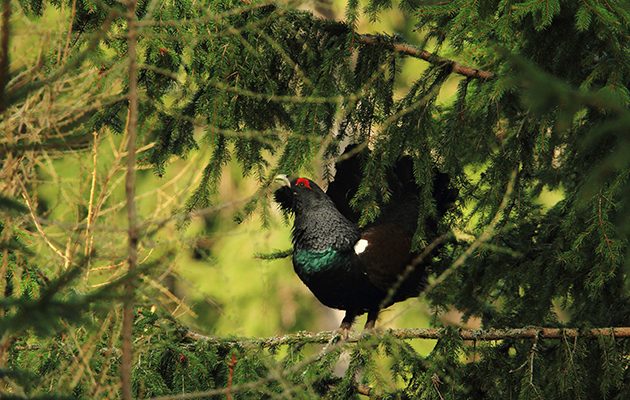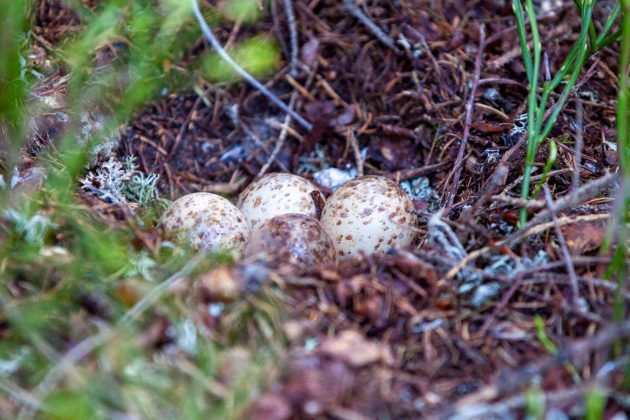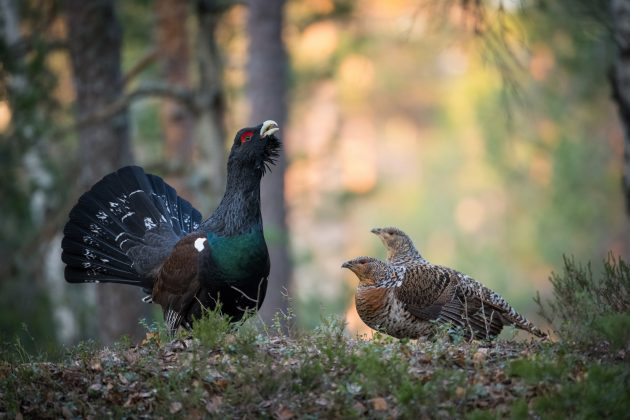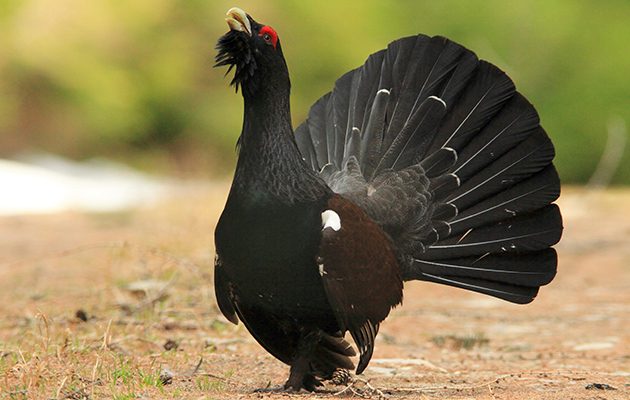The capercaillie, or woodland grouse, is in serious trouble, with predation a major concern, but helping this iconic bird will require some difficult choices to be made says Patrick Laurie
The current decline in Scotland’s capercaillie, the woodland grouse, presents a real risk that the bird will soon be driven into extinction. Cautious estimates suggest that we could lose the capercaillie from Scotland in the next 20 to 30 years, but their scarcity makes it desperately difficult to help them at a time when they need support more than ever before.
THE FIGHT TO SAVE SCOTLAND’S CAPERCAILLIE

Kinveachy Forest is part of Seafield & Strathspey Estates and is home to one of the last true strongholds for capercaillie in Scotland. While numbers remain viable at Kinveachy, the estate has not been immune to the declines that have struck so heavily elsewhere. Head gamekeeper Ewan Archer manages a team doing everything it can to turn things around for these extraordinary birds, but he is well aware of the challenges they face on the estate. “Capercaillie numbers have been dropping since the estimates of the 1970s, and our main aim now is simply to preserve this species from extinction,” says Archer. “If we continue with the current lack of productivity, we’re very concerned that we’ll lose this bird altogether.”
Even in their heyday, capercaillie were closely monitored at Kinveachy (numbers, productivity and lek counts), so the estate was better placed than many to identify real problems when numbers appeared to crash. Archer’s predecessor, Frank Law, remembers the birds in abundance, even back to a time when they were driven and shot on formal capercaillie days. “We’d aim for a bag of 10 or 20 birds in a day,” he says. “They were common back then. You’d expect to see a few of them every time you went into the forest, usually in the morning when they came out to find grit on the forest tracks.”
Seafield & Strathspey Estates stopped shooting capercaillie when declines were identified but the birds have continued to decline ever since, even after they were given full legal protection in 2001.
Capercaillie are closely associated with Caledonian pine forests, and individual birds will use a mosaic of habitats, including moorland, bog forest and stands of mature conifers, depending on the season. A vast amount of work has gone into regenerating extensive areas of ancient woodland, which were felled as part of the war effort, and Kinveachy is meeting its woodland creation goals through deer management and careful monitoring. Deer are culled to allow natural regeneration, but the year-round presence of herbivores at low densities means that brood-rearing habitats are kept open in a condition that is well suited to young capercaillie. Although it represents a great deal of hard work, this approach is more productive than the use of fences to exclude deer altogether.

Striking a balance with deer is not easy; however, there’s every sign that Archer’s team is getting things right. Kinveachy covers a large area, but capercaillie naturally move across even larger spaces during the course of a year. There is a sense that some neighbouring land managers are pulling in different directions when it comes to deer management and capercaillie conservation. It’s possible that Kinveachy is surrounded by less productive habitats where predator control is not treated as a high priority. This is an important issue to consider, even where collaboration and partnership working is generally good.
Beyond discussions around habitat creation and management, it’s clear that the birds are not responding. Without tackling other root causes of capercaillie decline, Archer’s fear is that at Kinveachy “we’re going to have a pristine woodland that is expanding in size and character but without its full potential biodiversity”. The estate is a clear example of where good habitat management alone is proving insufficient for capercaillie.
Dr Kathy Fletcher, senior research assistant at the GWCT, is confident that poor productivity is driving declines. This means that female birds are unable to produce enough youngsters each year to replace natural losses. There is some evidence to suggest that the problem is exacerbated by poor weather and recreational disturbance, but predation is a major concern. Fletcher’s work has contributed to a wider understanding of how crucial predator control can be for capercaillie. “We know that when predators like crows and pine martens are in high abundance, capercaillie are found at lower densities,” she says. “This is borne out and confirmed by a report for the capercaillie Scientific Advisory Committee (SAC), which was commissioned by NatureScot in 2021.”

The SAC report is clear about the drivers of decline, and it confirms what many gamekeepers and researchers have been saying for years. Habitat is not the limiting factor for capercaillie in Scotland and, acknowledging the hard work of estates like Kinveachy, it’s clear that more good habitat becomes available every year. In the words of the report: “Predation is a significant contributor to variation in breeding success. Increases in some nest predators (notably the pine marten) in recent years are likely to be contributing to the decline in capercaillie breeding success and hence population size.”
A proactive engagement with predator control at Kinveachy means that foxes and carrion crow numbers are kept at a low level, but pine martens are fully protected by law. There is no legal mechanism that allows them to be managed, and here is the root of the issue.
The pine marten is a native species to Scotland, although historical persecution meant that their impact was confined to a handful of marginal sites until relatively recently. As part of an extensive expansion across Scotland over recent years, pine martens returned to Strathspey during the 1970s. Their numbers have grown substantially ever since, and they have quickly become a common species in the area. Hard data is difficult to come by because capercaillie have become so scarce, but there is enough evidence to suggest that pine martens have become a significant predator of capercaillie. Both are protected by the same level of legislation, but it’s clear that one protected species could soon drive another into extinction.
For Law and Archer, predator control is clearly a crucially important tool for conserving capercaillie, but the work is only of limited value if pine marten numbers remain unmanaged. While some conservation organisations have tried to find a way around the issue, a range of land managers insist that the only practical way to save capercaillie is to introduce a legal mechanism to permit the lethal control of pine martens. “It might be possible to trial a range of new conservation measures in the future, but now is not the time,” says Law. “We might only have 400 or 500 of these birds left in Scotland. If we had 4,000 or 5,000, maybe there would be an opportunity to take our foot off the gas and see what else we can do. The goal now is simply to keep them in Scotland, full stop. We can still turn this situation around. It would be an act of folly to miss this opportunity.”

Many of the non-lethal techniques put forward as alternatives are impractical. Trapping and relocating pine martens is highly complex and expensive. Attempts to provide diversionary feeding are only in the earliest stages and results are unclear. GWCT Scotland director Rory Kennedy believes a way through could lie in contraceptive baits, a technique being trialled with grey squirrels. “The problem with issuing special licences for controlling pine martens is that to be effective, it would need to take place on a landscape scale,” says Kennedy. “Many estates surrounding Seafield and Strathspey will not countenance lethal control on ideological grounds. In addition, the current inability to address pine marten predation is used as a reason for many landowners to avoid the clear recommendations of the SAC regarding the need for crow and fox control across the entire capercaillie range. We need to address this if we are to save this species. Diversionary feeding combined with contraceptive population control could provide a workable outcome palatable to all parties.”
There are many factors to consider for the future. In parts of Scandinavia and Russia, pine martens and capercaillie are able to find a more natural balance that does not depend upon human intervention. It’s clear that capercaillie numbers are now so low in Scotland that normal rules do not apply. While it’s important to plan for a more natural future where predator and prey can find a lasting balance, the first challenge is to protect what we have to ensure these birds have a future at all. If we fail in this and lose the capercaillie from Scotland, there’s a risk that our pristine and resurgent Caledonian pine forests will always feel a little empty.
CAPERCAILLIES: A SPORTING AND NATURAL HISTORY
Written by Joe Dimbleby

Mystery surrounds the first extinction of capercaillie in Scotland around 1770, although the disappearance of what would most likely have been an indigenous subspecies has been attributed to the loss of Caledonian forest. It wasn’t until 1837 that capercaillie reappeared in Scotland, when Norfolk squire Sir Thomas Buxton arranged for his Irish gamekeeper, Larry Banville, to travel to Sweden to capture capercaillie for release on the Earl of Breadalbane’s estate at Taymouth Castle in Perthshire. The reintroduction was a great success and the population expanded its range widely.
British Birds (1930) lists them as spread throughout the Tay area, most of the Clyde, West Forth, Dee, Moray and north of East Ross-shire, with stragglers recorded from Wigtown and Dumfries in the south and Elgin in the north. Big bags were recorded in the early 20th century. In 1903, 136 capercaillie were killed in one season at Dunkeld, Perthshire and the record bag for a day was 69 on the same estate on 4 November 1910 by seven guns: the Duke of Atholl, the Marquis of Tullibardine, Lord George Murray, Colonel Ruggles-Brise, Count Clary, Captain Moray and Captain Wentworth. Other bags indicating good populations are 107 over three days in Fotheringham, Forfarshire in 1894, 60 killed on 14 December 1910 at Blackhall, Kincardineshire and 63 at Monymusk, Aberdeenshire in the same year.
In British Sporting Birds (1936), the Hon Douglas Cairns writes: ‘That the capercailzie [sic] was recognised as a bird of the chase before the days of firearms we may conclude from such sources as The Lament of Ardgour, in which the mourner, enumerating the exploits of Donald the Hunter, indicates the very spot where “pierced by his arrow the ‘cailzie cock fell”.
‘Today, capers certainly constitute a fascinating addition to many of those rough days whose results would without them be jejune. Not even the red grouse is more essentially a feature of his own landscape than is the primeval denizen of northern forests. One interpretation of the name is “witch or hag of the branch” and there is certainly an element of the uncanny in the silent launch of so heavy a body and the glide across the valley at a speed which has taken the conceit out of many an accomplished sportsman. It is to be hoped that game preservers, in so far as the future may be destined to lie in their hands, will be to his faults a little blind, and at any rate tolerate the presence of this characteristic aboriginal.”
Standing 50cm and weighing 4kg, with black and bottle-green feathers and a red flash above the eye, the cock capercaillie is described by Duff Hart-Davis as the ‘jeroboam’ of British birds. Normally elusive, the males become so territorial during the lek that they will attack sheep, humans and even vehicles. The capercaillie gets its name from the Gallic capall coille, which translates as ‘horse of the woods’.
They typically make a nest lined with pine needles at the foot of a tree. Nesting starts in early May and continues into early June, with six to eight eggs incubated by the hen alone. In the first few weeks, chicks rely heavily on ant larvae and insects. Adult birds’ diet includes tree buds, fruits, berries, acorns, heather tops and young shoots of larch and Scots pine. It is their fondness for the last that has brought them into conflict with commercial forestry. In the 1970s, when the Scottish population was around 20,000, they were treated as pests and there was a bounty on their heads. From this high point, they began a steady decline to the 400 or so remaining today.




